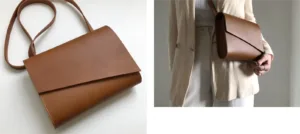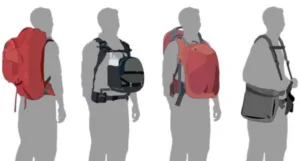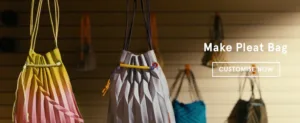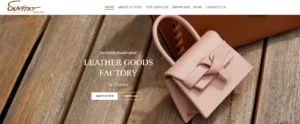Quilted leather has long been a symbol of elegance and craftsmanship in the world of fashion and design. With its distinctive padded texture and refined stitching, this luxury leather material instantly adds depth and sophistication to any product.
From quilted leather bags and wallets to jackets and even car interiors, its presence conveys both comfort and prestige. Loved by designers and consumers alike, quilted leather represents a perfect blend of artistry and practicality. In this guide, we’ll take a closer look at what quilted leather really is, how it’s made, its key advantages, and the best ways to care for this timeless material.
Contents
What Exactly Is Quilted Leather?

The definition of Quilted leather
Refers to a type of leather crafted by stitching together layers of leather and padding materials, creating a distinctive raised texture. This technique combines the outer leather surface with an inner soft padding—such as foam or batting—to produce a three-dimensional pattern that looks elegant and feels comfortable. The result is a surface that’s not only visually appealing but also adds depth, softness, and a touch of luxury to any product.
Understanding Quilted Leather Construction
Quilted leather isn’t defined by surface coating or thickness—it’s defined by structure. The typical composition includes three layers
| Layer | Material | Function |
|---|---|---|
| Outer Layer | Genuine leather, vegan leather, or PU | Provides surface texture, color, and luxury appearance |
| Inner Padding | Foam, cotton, or fiberfill | Adds softness and creates the raised 3D effect |
| Backing Layer | Fabric lining or non-woven material | Offers support and shape stability |
These layers are sewn together in specific patterns using precision stitching, resulting in a durable and stylish finish.
The History of Quilted Leather
“Luxury is in each detail, and texture tells the story.”
Origins
The story of quilted leather began in the grand ateliers of European fashion houses, where designers sought to blend comfort with couture. Legend has it that Coco Chanel was inspired by the padded jackets worn by horse riders and turned that practicality into pure elegance. “Texture gives life to simplicity,” a Parisian craftsman once said — and that’s exactly what quilting did. It transformed smooth leather into something that felt alive — soft, structured, and effortlessly chic.
Evolution
Originally, quilting appeared in horse saddle padding, purely for comfort and durability. Over time, this humble functional detail trotted off the stables and walked straight onto the runways. By the mid-20th century, quilting became a signature element of high fashion, adored for its sculpted look and refined touch. What once cushioned a horse now cushioned the world’s most stylish handbags. Talk about an upgrade.
Modern Use
Today, quilted leather is no longer just a fashion statement — it’s a mark of craftsmanship. From luxury bag manufacturers who stitch precision into every panel, to automotive designers upholstering car interiors that whisper luxury, quilting has become a cross-industry icon. Its charm lies in the balance between engineering and elegance, and let’s be honest — few things say “premium” quite like those perfect little diamonds.
Core Types of Quilted Leather Patterns
The design of quilted leather can vary widely depending on brand style, product type, and application. In the world of luxury bags, handbags, tote bags, and accessories, certain stitching patterns have become industry standards. Below, we will introduce the most recognized quilted leather patterns, highlighting diamond, square, and other popular designs commonly used by top bag manufacturers.
1. Diamond Quilting

The diamond quilted pattern is the timeless classic, widely used on tote bags and luxury handbags. Its intersecting lines create a sophisticated texture that feels plush yet structured. For customization, clients can choose stitch size, padding thickness, and leather type, ensuring each bag matches their brand’s aesthetic perfectly.
2. Vertical Quilting
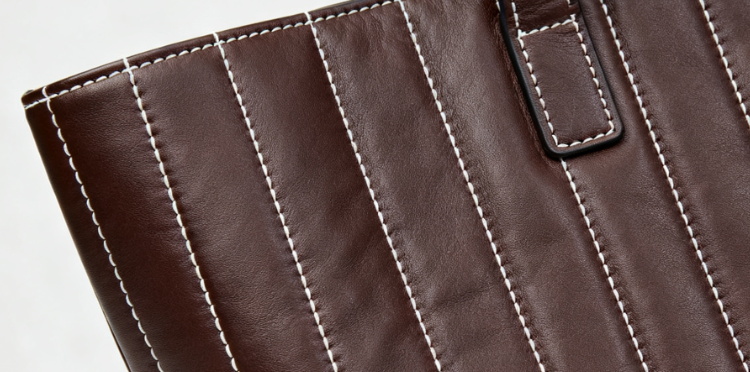
Vertical quilting offers a modern, streamlined look, making it popular for sleek handbags and contemporary tote bags. When customizing, brands can decide the line spacing and contrast stitching color, giving the final product a clean, upscale appearance that aligns with their design vision.
3. Wavy Quilting

With soft, flowing lines, wavy quilting gives a gentle, dynamic feel, often applied to fashion backpacks and travel bags. Customization allows clients to adjust the wave curvature, stitch density, and padding level, creating a unique tactile experience that combines comfort with style.
4. Custom Quilting Patterns

For brands seeking exclusive designs, custom quilting patterns enable the addition of logos, unique textures, or signature shapes. Through our OEM/ODM process, clients provide design files or sketches, and our skilled artisans translate them into precision-stitched, padded leather panels, ensuring that every bag is a true reflection of the brand’s identity.
| Pattern | Description | Typical Use |
|---|---|---|
| Diamond Quilt | The most classic, made famous by luxury fashion houses | Handbags, jackets |
| Chevron Quilt | Angular “V” lines for a modern, dynamic effect | Shoulder bags, car interiors |
| Square Quilt | Balanced and structured look | Travel bags, furniture |
| Wave Quilt | Flowing curved lines | Soft accessories, fashion items |
| Custom Patterns | Tailored designs for brand identity | OEM/ODM luxury projects |
Each pattern brings its own personality—from classic elegance to playful waves—while keeping the leather tough enough to survive your daily adventures (and maybe a coffee spill or two).
How Quilted Leather Is Made: Step by Step
At Sunteam, creating a quilted leather product is a coordinated effort across multiple departments, combining advanced machinery, skilled hands, and strict quality control. Here’s how the process works:
Step 1: Material Selection
The process begins with selecting the highest quality leather—either genuine hides or vegan alternatives. The materials department inspects each hide for texture, thickness, and color consistency, ensuring a flawless base for the quilting.
Step 2: Padding Application
Next, the production team applies foam or soft batting between the leather and its backing. This step adds volume and comfort while maintaining the leather’s structural integrity. Machines ensure even distribution, while skilled workers double-check for any irregularities.
Step 3: Pattern Marking
Once padded, the surface is marked with the desired quilting pattern—diamond, square, vertical, wavy, or custom designs. The design department ensures that each panel is precisely measured and aligned, setting up for a perfect 3D texture.
Step 4: Stitching Process
The stitching team uses specialized machines or hand-sewing techniques to bring the pattern to life. Advanced machinery at Sunteam ensures stitching tolerance within ±0.5 mm, giving each quilted panel a flawless and luxurious finish.
Step 5: Finishing & Inspection
Finally, the finishing department applies coatings, embossing, or polishing to enhance durability and appearance. Every panel undergoes a rigorous inspection to ensure consistency, elegance, and readiness for assembly into handbags, tote bags, travel bags, or other accessories.
Quilted Leather vs Regular Leather
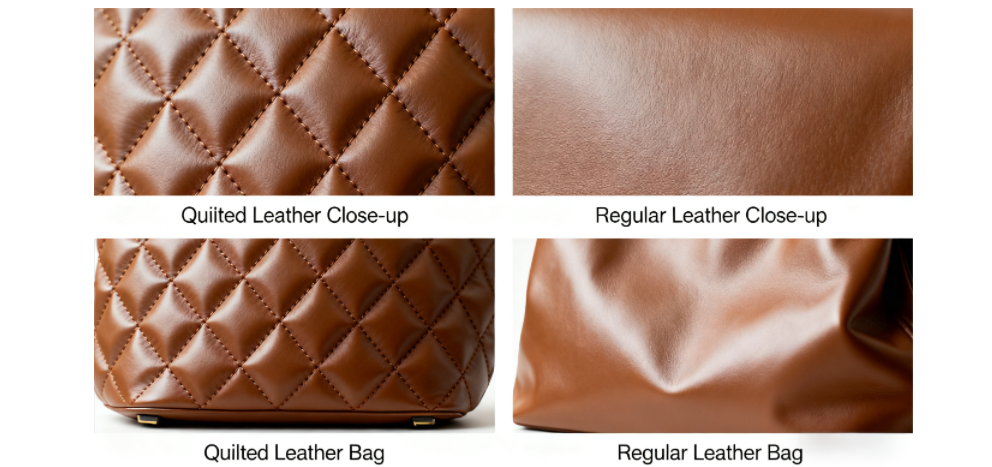
What Is Regular Leather?
Regular leather refers to leather that is tanned and treated from animal hides (or vegan alternatives) without additional padding or stitching layers. It retains its natural grain and smooth texture, offering durability based on the thickness and quality of the hide. This classic material is widely used in belts, wallets, shoes, and everyday accessories, valued for its simplicity, versatility, and timeless appeal.
Quilted Leather vs Regular Leather
| Feature | Quilted Leather | Regular Leather |
|---|---|---|
| Texture | Padded and stitched | Smooth or natural grain |
| Durability | Enhanced by layering | Depends on thickness |
| Appearance | More luxurious | Simpler and minimal |
| Common Use | Luxury handbags, tote bags | Belts, wallets, shoes |
Quilted leather is all about luxury, texture, and durability, perfect for handbags and tote bags that make a statement. Regular leather, meanwhile, is classic and versatile, great for everyday items like belts, wallets, and shoes.
Quilted Leather Price Tip for Buyers

The price of quilted leather can vary based on several key factors:
Leather type – Whether you choose genuine leather, PU leather, or vegan alternatives, the material quality has a major impact on cost. Premium hides naturally command higher prices.
Quilting complexity – Intricate patterns like custom tote bag logos or wavy designs require more time and skill, which can increase the price.
Stitching precision – Fine, uniform stitching with tight tolerances adds to labor and machinery costs, but ensures a luxurious and durable finish.
Order volume (MOQ) – Larger orders typically lower the unit cost, while small batches or prototypes may be slightly more expensive per piece.
Quilted Leather Price range:
PU Quilted Leather: approximately $4–8/m², offering a cost-effective option for stylish yet affordable products.
Genuine Leather: around $20–50/m², depending on hide grade, thickness, and finishing.
Pro Tip: For small batch or custom bags, consider suppliers like Sunteam, which offer low MOQ, flexible OEM/ODM services, and expert craftsmanship. This way, you can control costs without compromising quality, ensuring every quilted bag meets your brand’s standards.
Conclusion
Quilted leather perfectly blends craftsmanship and style, offering both functionality and elegance. For brands, it serves as a symbol of luxury and high-end appeal; for manufacturers, it showcases technical skill and precision.
Whether you’re designing handbags, tote bags, or travel accessories, quilted leather provides a durable structure with a luxurious touch, making it an ideal choice for products that need to impress—without sacrificing practicality.


